AI Essay Humanizer tools are essential in 2025 for anyone working with AI-generated content. These tools help transform robotic or formulaic AI drafts into essays that sound like they were written by a real person. Whether you’re a student, writer, or business professional, humanizing your AI output ensures higher engagement, better readability, and improved authenticity.
According to a survey, 73.6% of students use AI for writing tasks, and over 46.3% rely on it for essay drafts. UK university data shows that generative AI usage by students jumped from 66% in 2024 to 92% in 2025, underscoring the demand for tools that ensure content feels natural and personalized.
The Top 9 Best AI Essay Humanizer Tools 2025
1. Gpthumanizer.io

Gpthumanizer.io is the best AI Essay Humanizer, especially designed to polish essays with professional-grade precision. Also this tools offer a lot of customization that makes your content more creative giving it a tone or choose between a formal or non formal type of content.
Unlike basic paraphrasers, it includes a built-in AI detection system that helps you verify your final content won’t be flagged by school or platform AI checkers. It also accepts uploads in DOCX and PDF formats, which makes it easy for academic users to process full essays.
In addition, Gpthumanizer.io keeps track of transformation history, so users can review what was changed. The platform is ideal for academic writing, blog content, or marketing copy.
Read more: 10 Best AI Humanizer
Features:
- AI detection integration
- Upload Word or PDF documents
- Preserves original meaning while improving fluency
- Tracks transformation history
Pricing:
- Free: 125-word limit per request
- Pro: $9.99/month
- Team: $29.99/month
2. QuillBot
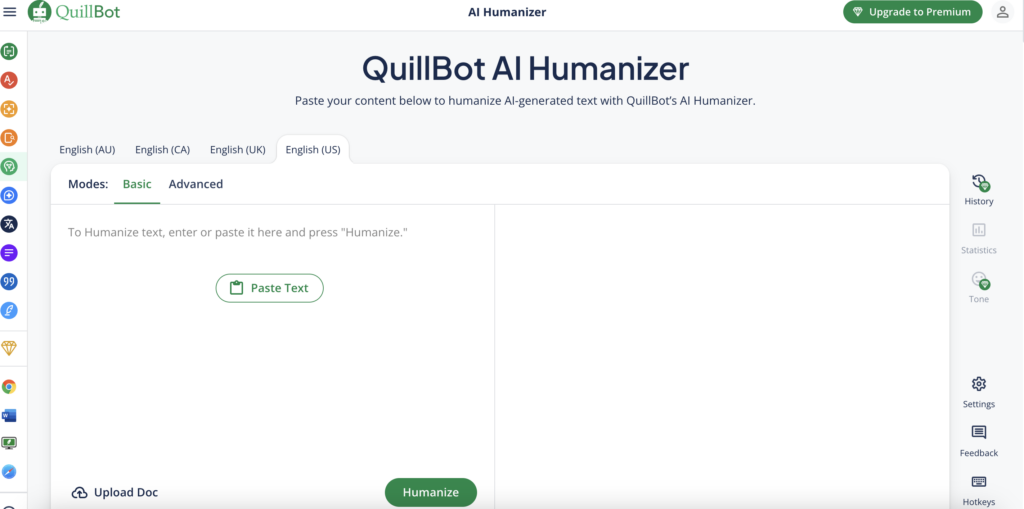
QuillBot is one of the most popular AI rewording tools globally, trusted by millions of students and professionals. It’s not just a paraphraser—it includes multiple writing tools such as a grammar checker, plagiarism detector, and citation generator.
QuillBot supports various rewriting modes like Creative, Formal, Shorten, and Expand, which allow users to adapt the tone and flow of any AI-generated text.
Features:
- 7+ paraphrasing modes including Creative and Formal
- Grammar and plagiarism checker
- Citation generator
Pricing:
- Free: 125-word limit per paraphrase
- Premium: $8.33–$19.95/month
- Team: $5.83–$7.50/user/month
3. Wordtune
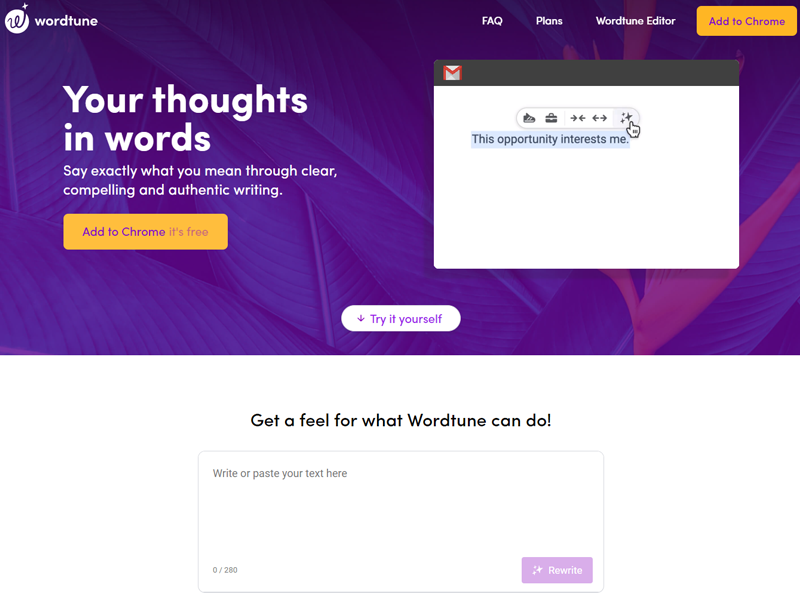
Wordtune is an intelligent AI humanizer that excels in style, tone, and clarity. It lets users rewrite sentences to sound more formal, casual, or concise—ideal for editing AI essays that might feel mechanical. What makes Wordtune unique is its real-time feedback and the ability to modify the length or style of entire paragraphs, which is crucial for humanizing academic writing.
Another major plus is Wordtune’s ability to summarize long-form content, including YouTube videos and PDFs. Its grammar correction is subtle but powerful, which ensures your humanized output is not only fluid but also grammatically solid.
Features:
- Rewrite for tone: casual, formal, concise, or expanded
- AI summarizer for articles, PDFs, and even YouTube videos
- Integrated grammar and spelling checker
- Chrome and Word integrations
Pricing:
- Free: 10 rewrites/day
- Advanced: $4.89–$6.99/month
- Unlimited: $6.99–$9.99/month
4. Grammarly Premium

Grammarly Premium goes far beyond grammar—it’s a writing assistant that transforms robotic AI output into natural, persuasive text. It uses tone detection and sentence engagement tools to refine AI-written essays, helping you make your writing sound human, not programmed. This is essential for academic or professional settings where a personal voice matters.
It supports real-time feedback in web browsers, Microsoft Word, Google Docs, and even desktop applications. Grammarly Premium also includes a plagiarism detector and vocabulary suggestions.
Features:
- Advanced tone detection
- Sentence fluency and engagement suggestions
- Integrated plagiarism checker
- Browser and desktop app support
Pricing:
- $12–$30/month depending on subscription plan
5. Hemingway Editor
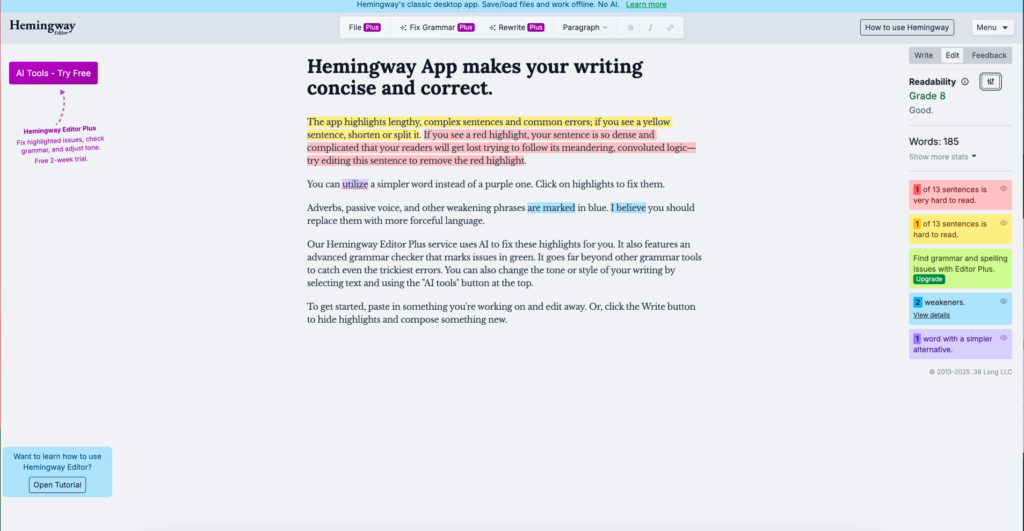
Hemingway Editor is a classic tool that strips down overcomplicated AI-generated content. It highlights long sentences, passive voice, and confusing structure, helping you humanize text by making it punchier and more readable. It’s perfect for essays and articles that feel too stiff or technical.
The interface is color-coded for clarity and offers a readability grade score. It doesn’t change your content automatically—instead, it guides your revisions, which is ideal if you want to maintain control over the final tone.
Features:
- Readability scoring system
- Highlights passive voice and overused adverbs
- Simplifies long or complex sentences
Pricing:
- Free: browser-based version
- $19.99: one-time purchase for desktop app
6. Draftable
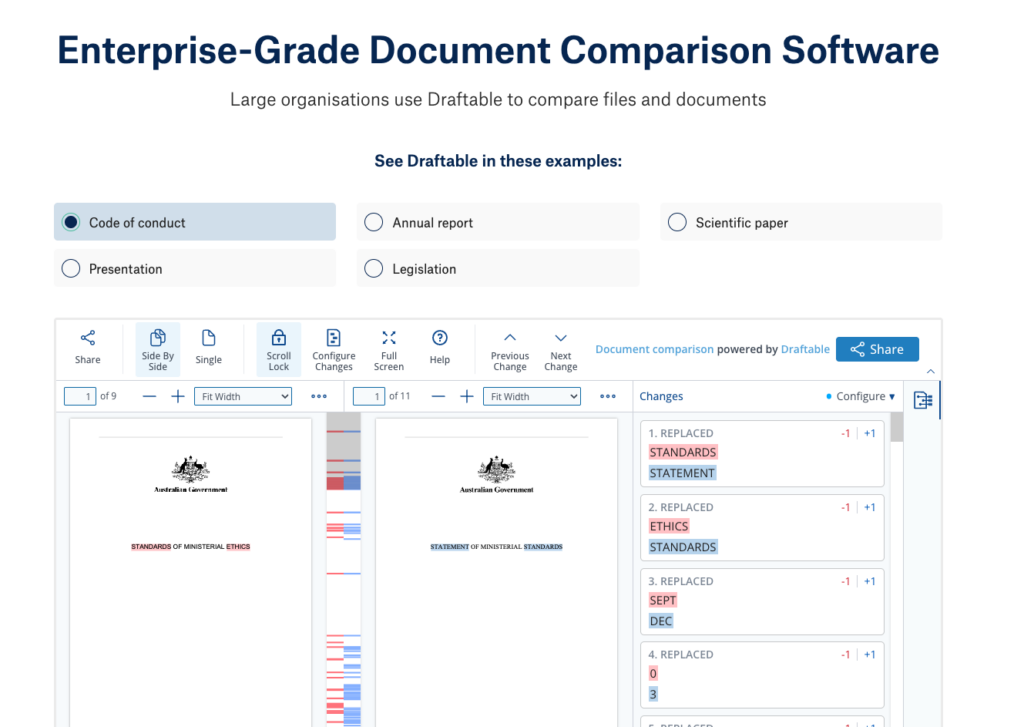
Draftable is not a typical AI essay humanizer—it’s a comparison tool that shows what has changed between your original AI output and your revised (humanized) version. This side-by-side view is especially helpful for editing teams or academic writers who want to see what edits are improving tone or readability.
It's a lightweight, browser-based platform that’s easy to use and perfect for tracking how well your AI essay has been humanized over time.
Features:
- Side-by-side text comparison
- Highlights changes between versions
- Useful for documenting edits over time
Pricing:
- Free basic version
- Pro: $15–$20/month
7. Paraphraser.io

Paraphraser.io offers fast and easy text rewriting with several modes, including Creative and Fluency. It’s especially useful for transforming rigid or repetitive AI content into more dynamic language. While it doesn't have advanced integrations, its simplicity and speed make it great for students who need quick results.
It supports bulk input and is accessible from any browser.
Features:
- Multiple paraphrasing modes
- Large text input support
- Offers academic-friendly rewriting styles
Pricing:
- Free with usage limits
- Premium: ~$5–$10/month
8. PaperRater
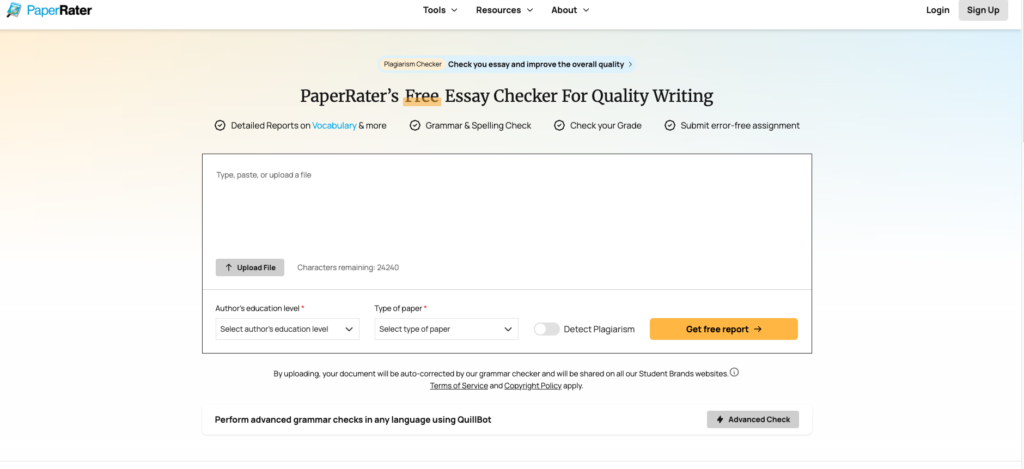
PaperRater combines several tools in one: grammar checker, plagiarism detector, and essay reviewer. While it’s not as advanced as Grammarly, it’s excellent for early-stage humanization of AI content. It reviews sentence structure and vocabulary while providing real-time feedback.
Features:
- Real-time grammar and spelling feedback
- Plagiarism detection
- Vocabulary and writing suggestions
Pricing:
- Free with ads and limits
- Premium: $11.21/month or $95.88/year
9. WordAI

WordAI is a powerful rewriting engine designed for professionals. It focuses on generating high-quality, natural-sounding variations of original text. WordAI uses deep learning to rewrite content with attention to grammar, tone, and context—making it ideal for high-stakes documents that must feel human.
Unlike lighter tools, WordAI can handle bulk spinning, making it perfect for long essays or multiple assignments. It’s also great for content creators and SEO writers.
Features:
- Context-aware rewriting engine
- Improves sentence variation and tone
- Supports bulk spinning for large essays
Pricing:
- $49.95/month
- Annual: $347.40/year (~$28.95/month)
Read more: How to remove ChatGPT Watermarks (Guide)
Final Take
If you’re serious about writing in 2025, a good AI Essay Humanizer is indispensable. Gpthumanizer.io stands out for its speed and quality, while QuillBot and Wordtune offer flexible, affordable options. Combine tools like Grammarly Premium and Hemingway Editor for the best editing results.
As one of the co-founders of Codeless, I bring to the table expertise in developing WordPress and web applications, as well as a track record of effectively managing hosting and servers. My passion for acquiring knowledge and my enthusiasm for constructing and testing novel technologies drive me to constantly innovate and improve.
Expertise:
Web Development,
Web Design,
Linux System Administration,
SEO
Experience:
15 years of experience in Web Development by developing and designing some of the most popular WordPress Themes like Specular, Tower, and Folie.
Education:
I have a degree in Engineering Physics and MSC in Material Science and Opto Electronics.



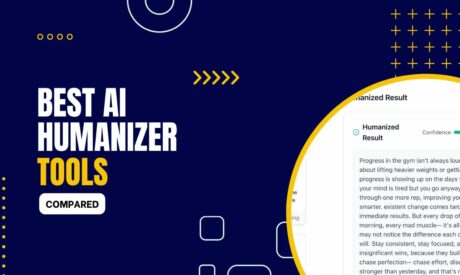





Comments